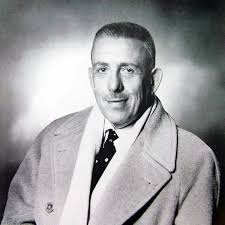
Francis Poulenc
Francis Poulenc knew all the best poets, setting the works of Apollinaire and Éluard again and again. He set the poets to opera (Les Mamelles de Tiresias), for a cappella choir, for voice and piano, in a secular cantata (Figure humaine), and so on. In fact, Poulenc once wrote “If one placed on my tomb the inscription ‘Here lies Francis Poulenc, the musician of Apollinaire and Éluard,’ I think it would be the finest claim to fame.”

Paul Éluard
Paul Éluard (1895-1952) was not only a poet but also one of the founders of the Surrealist movement. After a difficult WWI, where he started by writing letters of condolence and ended as a full soldier, he found a new life in the post-war era with a group of poets that include André Breton. Inspired by the Dadaist movement in France, he went to Cologne to meet its founder, Max Ernst. Migrating illegally to France, Ernst lived in a ménage à trois with Éluard and his wife Gala. Éluard finally fled and was located in Saigon. In 1928, his tuberculosis put him into a sanatorium and his wife left him for Salvador Dalí, with whom she remained for the rest of her life. Éluard had a political life, joining and being banned from the French Communist party. During WWII his poem “Liberté’ was parachuted in the thousands by English aircraft over occupied France, and at the end of the war he was hailed as one of the great poets of the Resistance.

Poulenc’s Le travail du peintre first edition cover, design by Picasso
In 1956, Poulenc set a group of 7 poems under the title Le Travail du Peintre (The Painter’s Work) with each poem based on a separate painter. The poems come from a variety of Éluard poems and collections, but had been renamed by Éluard for Poulenc’s setting.
Le Travail du Peintre (translation)
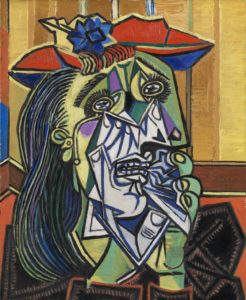
Picasso: Weeping Woman (1937) (Tate)
The first song, “Pablo Picasso,” comes from long poem entitled ‘Travail du peintre,’ which had appeared in Éluard’s Poésie ininterrompue of 1946. Poulenc only sets the first part of the poem. Picasso had the literal first place because he also designed the cover for this music.
The poem is full of colours: lemon yellow, white, black, azure and seems to describe Picasso’s distinctive rapid drawing style, asking ‘pourquoi pas’ (why not) as one word is joined by another, a mouth is like a feather, smiles and tears join, all renounced by a ‘single movement of the eyelids.’
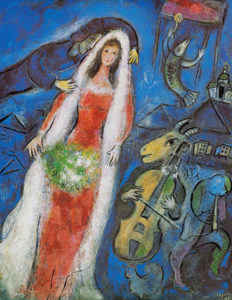
Chagall: La Mariée (1950) (Private Collection, Japan)
‘Marc Chagall’ follows, filled with the images of many Chagall paintings: animals, a singing bird, a violin, an agile dancer and his wife.

Braque: Violin and Sheet Music: “Petite Oiseau” (1913) (Metropolitan Museum of Art)
The poem ‘Georges Braque’ takes as its center a bird, flying away, without a shadow, flying into the light. It closes with ‘a man with light eyes’ who describes ‘the sky of love,’ gathering in the wonders like birds in their wings.
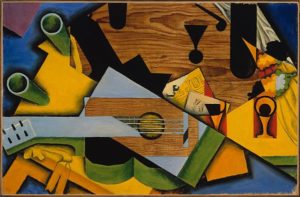
Gris: Still Life with a Guitar (1913) (Metropolitan Museum of Art)
‘Juan Gris’ contrasts the day world with the night world – one shows the merciless present while the other is full of shadow. This is one of the best known of these 7 songs.
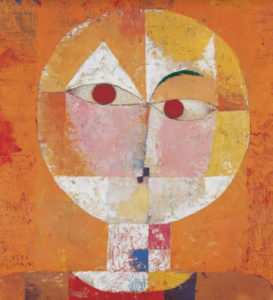
Klee: Senecio (1922)
Paul Klee, whose painting with lines and shapes seemed to reduce the complexity of life to understandable lines and colours, is set to music that changes the slow texture we’ve heard so far and makes it more heroic, as though reading behind the images.
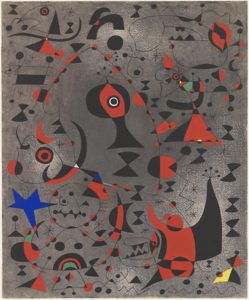
Miró: Constellation: Toward the Rainbow (1941)
(Metropolitan Museum of Art)
More abstract than Klee, Joan Miró created a world where shapes float in space, almost child-like in their presentation, yet with an integral aesthetic that draws us into their surreal placement. Shapes move and shift, colours change, and in the poetry Éluard keeps removing elements: remove the hill, the forest…all is dissipated with a wave of the artist’s hand.

Villon, Girl at the Piano (Fillette au piano) (1912) Museum of Modern Art, New York
The cycles closes with Jacques Villon, perhaps the least familiar of the 7 artists. He was an older brother of the more famous Marcel Duchamp, and worked in a variety of styles at the turn of the century, including Fauve, Cubist, and abstract impressionism. He worked largely in Normandie, away from the Paris art centre in Montmartre, and it was his 1944 exhibition in Paris that brought him international recognition. Éluard’s poem pushes forth Villon as someone who has conquered all, despite all that got in the way.
The poetry of Éluard in the hands of Poulenc has given us a unique view into the impressively creative world of art of 20th century Paris.




